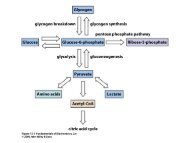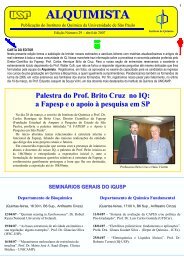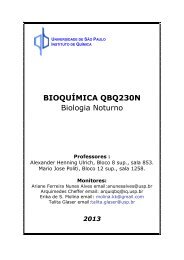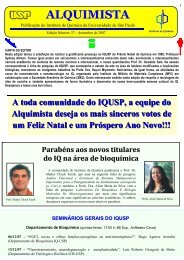Studies on PVP hydrogel-supported luminol ... - ResearchGate
Studies on PVP hydrogel-supported luminol ... - ResearchGate
Studies on PVP hydrogel-supported luminol ... - ResearchGate
Create successful ePaper yourself
Turn your PDF publications into a flip-book with our unique Google optimized e-Paper software.
Calibrati<strong>on</strong> analytical applicati<strong>on</strong>s studies <strong>on</strong> <strong>PVP</strong> <strong>hydrogel</strong>-<strong>supported</strong> <strong>luminol</strong> CL ORIGINAL RESEARCH ORIGINAL RESEARCH5of 6.8 × 10 −7 mol/L. The regressi<strong>on</strong> equati<strong>on</strong> for thelinear dependence is S C = 7.78 × 10 −11 + 1.05 × 10 −5 [H 2 O 2 ]with correlati<strong>on</strong> coefficient (R) = 0.9977 (n = 6). Athigher peroxide c<strong>on</strong>centrati<strong>on</strong>s the total light emissi<strong>on</strong>shows a significant decrease (Fig. 3A, insert), a factwhich may indicate the destructi<strong>on</strong> of hemin by excessof peroxide and incomplete c<strong>on</strong>versi<strong>on</strong> of hydrogenperoxide. Similar results are obtained if the initial emissi<strong>on</strong>intensities are correlated with [H 2 O 2 ]; in this casethe regressi<strong>on</strong> equati<strong>on</strong> for the linear dependence isI C = 9.04 × 10 −16 + 5.83 × 10 −10 [H 2 O 2 ] with R = 0.9998(n = 6). Also the light intensities show a sharp decreaseat higher peroxide c<strong>on</strong>centrati<strong>on</strong>s (Fig. 3B).As can be seen from Table 1, the observed detecti<strong>on</strong>limit (6.8 × 10 −7 mol/L) is compatible with several otherdetecti<strong>on</strong> methods based <strong>on</strong> <strong>luminol</strong> CL, immobilized orin soluti<strong>on</strong> (21–29).We also can predict from the MFA that the linearrange of the peroxide dependence can be extended tohigher c<strong>on</strong>centrati<strong>on</strong>s by using higher hemin c<strong>on</strong>centrati<strong>on</strong>s,without significant changes in the detecti<strong>on</strong> limit(11). The results obtained for the detecti<strong>on</strong> of hydrogenperoxide are very promising in terms of applicati<strong>on</strong> automati<strong>on</strong>.For example, oxidases could be inserted intothe polymeric matrix together with <strong>luminol</strong> and hemin,allowing the automatic detecti<strong>on</strong> of specific substrates,such as glucose or lactose, in the µmol/L c<strong>on</strong>centrati<strong>on</strong>range by quantificati<strong>on</strong> of hydrogen peroxide generatedby enzyme catalysed substrate oxidati<strong>on</strong> (30, 31).Figure 3. Correlati<strong>on</strong> of total light emissi<strong>on</strong> (A) and emissi<strong>on</strong>intensity (B) with the hydrogen peroxide c<strong>on</strong>centrati<strong>on</strong>.[Luminol], 1.0 mmol/L; [hemin], 7.7 nmol/L; [<strong>PVP</strong>], 80 mg/mL.c<strong>on</strong>centrati<strong>on</strong>s), since we are interested here in detectingH 2 O 2 at the low c<strong>on</strong>centrati<strong>on</strong> range. A lineardependence of the calibrated total light emissi<strong>on</strong> (S C )with the c<strong>on</strong>centrati<strong>on</strong> of H 2 O 2 is observed up to 5 ×10 −4 mol/L (Fig. 3A), with an estimated detecti<strong>on</strong> limitAntiradical assay: effect of Trolox <strong>on</strong> emissi<strong>on</strong>intensities and emissi<strong>on</strong> areasIn order to use the <strong>luminol</strong> CL as the basis ofan antiradical assay, the kinetics should c<strong>on</strong>sist in slowlight emissi<strong>on</strong> decay (32). This behaviour indicates ac<strong>on</strong>stant, or nearly c<strong>on</strong>stant, producti<strong>on</strong> of free radicalintermediates derived from <strong>luminol</strong>, hemin and hydrogenperoxide. From our MFA we chose intermediatec<strong>on</strong>centrati<strong>on</strong>s of all the three reagents to access slowemissi<strong>on</strong> decay and a relatively slow c<strong>on</strong>sumpti<strong>on</strong> of theTable 1. Detecti<strong>on</strong> limits for hydrogen peroxide using several chemiluminescencemethodsDetecti<strong>on</strong> limitSystem (mol/L) ReferenceLuminol–KIO 4 3.0 × 10 −8 (21)Luminol–K 3 Fe(CN) 6 6.0 × 10 −6 (22)Luminol–HRP 8.0 × 10 −6 (24)Luminol–peroxidase 1.0 × 10 −8 (25)Luminol–Co(II) 5.0 × 10 −9 (26)Luminol–calixarene/Cu(II) 3.0 × 10 −6 (27)DTMC 4.0 × 10 −8 (28)Luminol–hemin 3.0 × 10 −9 (23)Luminol–hemin–<strong>PVP</strong> 6.8 × 10 −7 This workDTCM, 7-(4,6-Dichloro-1,3,5-triazinylamino)-4-methylcoumarin.Copyright © 2006 John Wiley & S<strong>on</strong>s, Ltd.Luminescence (In press)DOI: 10.1002/bio



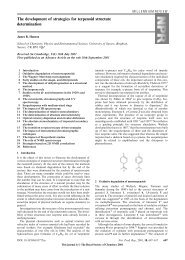
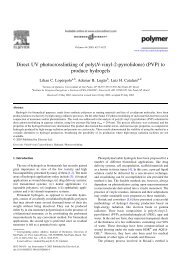
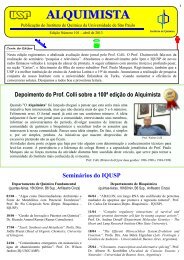
![PE]+ + N. Fragmentação por clivagem sigma](https://img.yumpu.com/50134385/1/180x260/pe-n-fragmentaaao-por-clivagem-sigma.jpg?quality=85)




